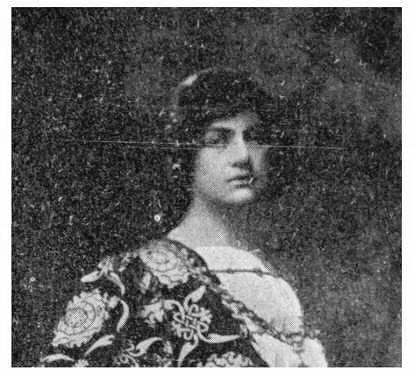Guardabassi (Count Francesco Mario) was of noble birth and a skilled portrait painter.
He went for the first time to the US in 1893 to display his paintings of Pope Leo XIII at the Chicago World's Fair.
Here, he became interested in singing and decided to return to
Italy to study.
He returned to the U.S. in 1903, and made his debut at the Met as Silvio.
Guardabassi sang two roles with the Metropolitan Opera Company:
Silvio and Morales, besides a concert.
He sang Silvio for the first time on December 9th, 1903 with Sembrich, Caruso, Scotti,
Reiss and Vigna conducting.
Mr. Guardabassi's first appearance, which was in the character of Silvio,
was made under circumstances that were evidently embarrassing to him,
for he betrayed what can scarcely be described as anything but absolute
fright. It had its unmistakable effects upon his appearance and action,
which were extremely constrained, and upon his singing. His voice seemed
as if it might be an agreeable and a serviceable one under more favorable
conditions.
New York Times
|
His Met appearances were:
Pagliacci on 9/14/26 December 1903 (New York),
2/15 January 1904 (New York),
12 January 1904 (Philadelphia).
Fourth Grand Sunday Night Concert, Metropolitan Opera House on 20 December 1903,
Guardabassi singing Le roi de Lahore: Promesse de mon avenir.
Carmen on 6/19 February 1904 (New York), 9 February 1904 (Philadelphia),
2 March 1904 (New York),
9 March 1904 (Washington D. C.), 16/26 March 1904 (Chicago), 31 March 1904
(Pittsburgh), 16 April 1904 (Boston), 22 April 1904 (New Haven).
He was not very successful as a baritone and reappeared in 1909 as a tenor. His career evolved
as follows:
1909 Warsaw (Tosca in January), Alessandria (Cavalleria rusticana, in October, sharing with Ottavio Frosini and Luigi
Cucci, partnering Ada Sari, Ida Mannarini, Amedeo Bertazzoni
1910 Schio, Chicago
 New York Times, 2 October 1910
New York Times, 2 October 1910
1911 Chicago, Philadelphia (Carmen on 25 January/13 February/24 March; Cavalleria rusticana on 18 February/29 March; Quo
vadis on 31 March/4 April, the latter a tour performance at the Metropolitan Opera House in New York; act 4 from Faust on 1
April; Pagliacci on 11 November)
1912 Philadelphia (Quo vadis on 12 February; Pagliacci on 2 March; Carmen on 9 March), Baltimore (Pagliacci on 7 March,
tour performance of the Philadelphia opera company)
Upon the outbreak of World
War I, he returned to Italy and enlisted as a volunteer, earning the rank of a Captain.
 New York Times, 5 May 1918
New York Times, 5 May 1918
Returning to the US, he received an important
commission from the Italian embassy and promoted Italian culture.
His repertory included: Silvio, Morales, José, Roméo, Cavaradossi, Turiddu, Canio, Radamès,
Faust, Vinicius, ...


